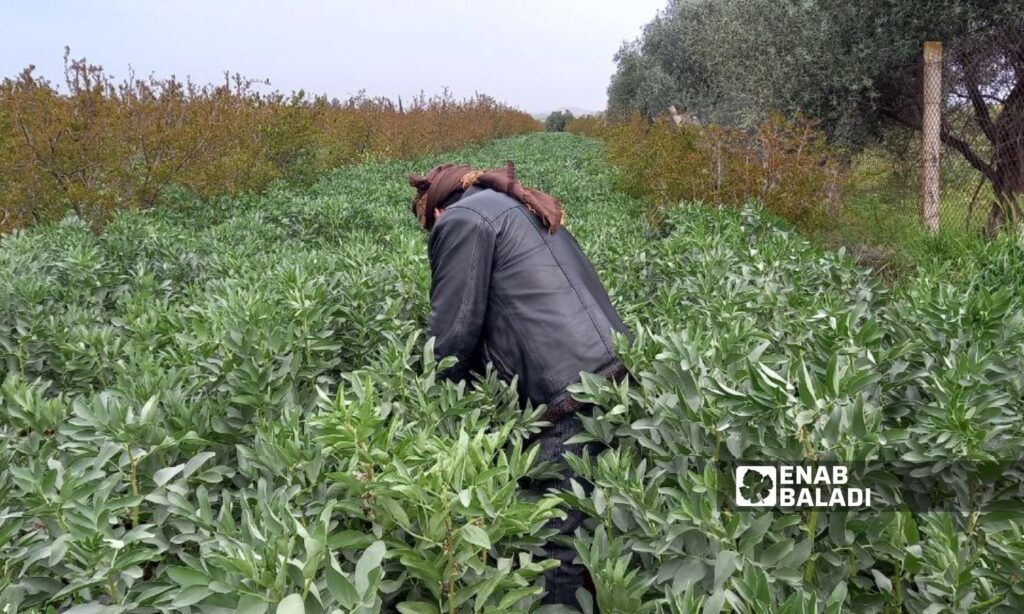Daraa – Halim Muhammad
The price of green broad beans in Daraa province, southern Syria, has dropped during the peak of its production season since mid-March, with the price per kilo reaching 2,000 Syrian pounds after it ranged between 7,000 and 9,000 Syrian pounds at the beginning of the month.
The area of land planted with broad beans in Daraa this season amounts to 3,024 hectares and is concentrated in the western countryside of Daraa in the fields of Tafas, Jalin, Tel Shihab, Da’el, and Nawa. These areas supply the wholesale vegetable markets in Daraa and Damascus.
Does not cover the costs
Saad al-Din Kiwan, a farmer in the western countryside of Daraa, collected about a ton of broad beans from his crop on March 23 and shipped it to the wholesale market in Damascus to be sold at 2,000 pounds per kilo.
The price decrease prompted Kiwan to stop harvesting and selling the beans green because he said it was a losing business. He noted that he would leave the crop until harvest time.
He added to Enab Baladi that the cost of transporting by agricultural truck to Damascus is one million Syrian pounds ($72), a high amount linked to fuel prices, as the price of diesel per liter has reached 13,000 Syrian pounds.
Additionally, there has been an increase in labor wages; the wage for a worker is 30,000 Syrian pounds for every five hours of work, and approximately 20 workers are needed to harvest a ton of beans, bringing the total to 600,000 Syrian pounds.
Also, the prices of polystyrene boxes have risen, with one box that fits 15 kilograms of beans costing 4,000 Syrian pounds, and one ton requires 66 boxes, amounting to 264,000 Syrian pounds.
Glut of supply
Farmers in Daraa began harvesting green broad beans at the beginning of March, and due to the selling price being low compared to the costs, most of them have backed down from harvesting.
Nizar (30 years old), who buys and rents crops from farmers in what is known as “land leasing,” said that the reason for the low prices of beans is the surplus supply against falling demand, especially during the month of Ramadan (which started on March 11).
He added that the price of a kilo of green broad beans reached 8,000 pounds before Ramadan, which was profitable for the farmer, but the peak production of the crop did not reach its limit until mid-March, and the excess quantities flooded the market, coinciding with Ramadan.
Waiting for the harvest
Broad beans are legumes that are widely grown in Syria, and the timing of their cultivation varies by region. They are planted in warm regions (coastal and the Hauran area) between mid-September and early November.
The harvesting of the green pods starts within a period of three to three and a half months from the appearance of the sprouts, and the harvesting season lasts from one and a half to two months, where they are picked once every week after they have fully grown and before they dry out.
If the crop is left to dry, it is harvested after a period of five to five and a half months from germination, after the fruits fill out, the vines begin to yellow, the lower leaves start drying out and falling, the lower pods begin to open, and the stem starts turning brown.
Agricultural engineer Khaled Suleiman told Enab Baladi that new varieties of broad bean seeds have entered the market over the past few years, such as Turkish, Maltese, and German varieties, which are high-yielding but have small seed sizes and are preferred as fodder; hence, they are sold in the market as green beans.
The Cypriot variety is known for the quality of its fruit but yields less than the aforementioned varieties, and its price as seeds is higher. This variety is preferred by restaurants, according to the engineer, noting that the productivity of a dunam of broad beans ranges between 300 and 500 kilos of grains.

